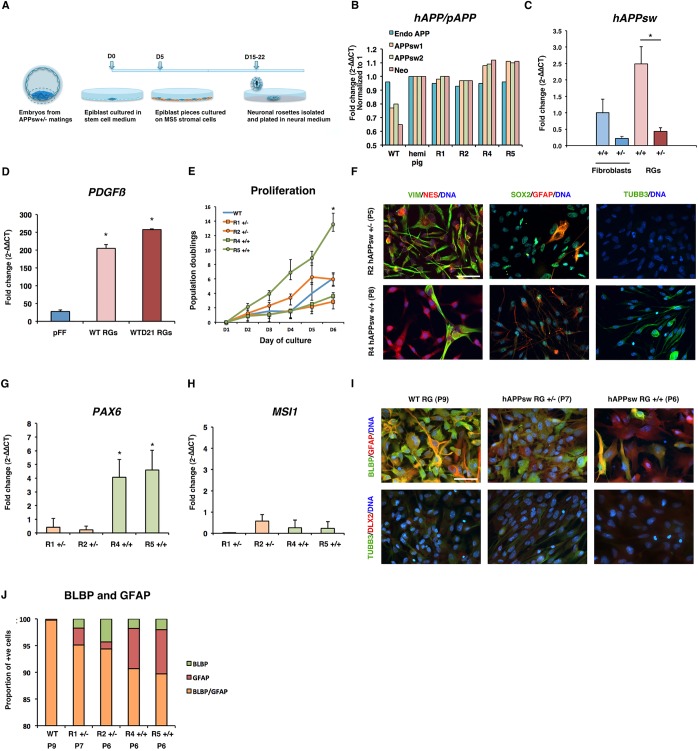Fig. 1.
Production and characterization of radial glial cells (RGs) from transgenic porcine embryonic stem cells, carrying the human APP Swedish mutation (hAPPsw). (A) Overview of the procedure for the establishment of RGs. (B) Genotyping of lines using comparative qPCR revealed that two lines were hemizygous and two homozygous. (C) Expression of hAPPsw in hAPPsw+/− and hAPPsw+/+ fibroblasts and RGs. Student's t-test was performed and significance was found when P≤0.05 (marked by *). (D) Expression of PDGFβ by comparative qPCR revealed increased expression in hAPPsw RGs and hAPPsw RG-differentiated astrocytes compared with non-transgenic porcine fetal fibroblasts (pFFs). Student's t-test was performed and significance was found when P≤0.05 (marked by *). (E) Population doublings of WT and hAPPsw RGs reveal that all lines proliferate at similar rates, except for R5 hAPPsw+/+ line, which proliferates faster. A total of three biological replicates were performed and displayed as the mean. Error bars represent s.d. Student's t-test was performed and significance was found when P≤0.05 (marked by *). (F) Expression of neural stem cell markers reveals that the cells have a neural progenitor phenotype. Immunocytochemistry was performed for VIM, NES, SOX2, GFAP and TUBB3. Magnification: 40×; scale bar: 100 µm. (G) Expression of PAX6 in the RGs revealed increased expression in the hAPPsw+/+ lines. Student's t-test was performed and significance was found when P≤0.05 (marked by *). (H) Expression of MSI1 in hAPPsw lines did not differ significantly. (I) RGs co-express the radial glial marker BLBP but are negative for the expression of DLX2 (a marker of neuroblasts from the subventricular zone). Magnification: 40×; scale bar: 100 µm. (J) Cell counting of the proportion of BLBP+ and GFAP+ cells reveal that most cells are double-positive for BLBP/GFAP in the WT and APPsw RGs. A larger proportion of single GFAP+ cells are found in the APPsw+/+ R5 cell line compared with the other cell lines.

